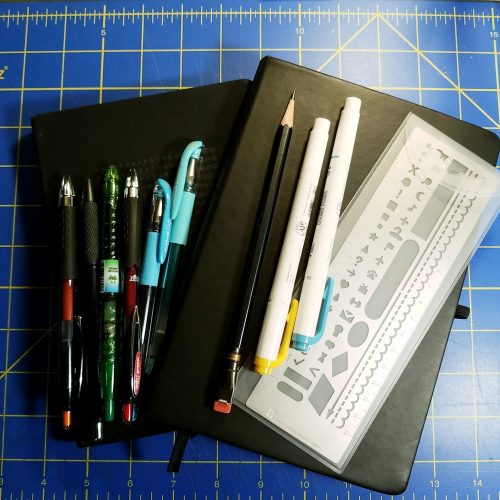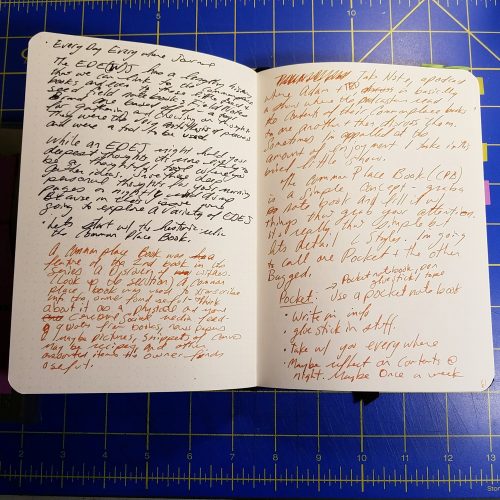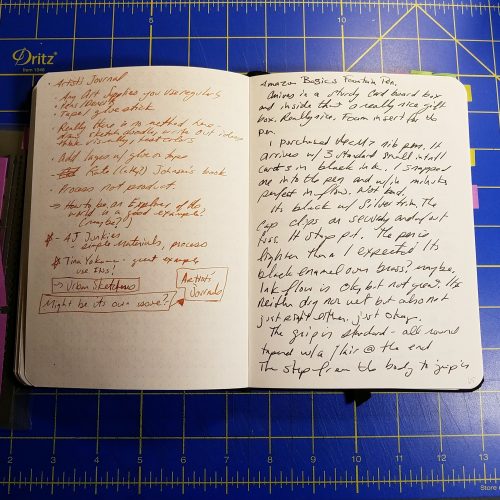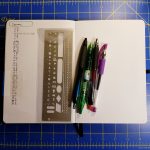I mentioned on instagram that I had decided to retire my 2020 Every Thing Every Where Journal (ETEWJ) and start a fresh one for 2021. I never do this. The whole POINT of the ETEWJ is that it is flexible and not retrained by dates or years, rather it flows undated with my needs and my uses. The next issue of Useful Journaling (1.3) explores the idea of Every Thing Every Where Journals.
My need for 2021 is to leave behind 2020. Also, the Baronfig Work/Play III has a lot of really intense journaling that needs to be left behind, though referred to often. Mostly I did not want to carry that weight with me on the daily.
So I ripped open my new ScribblSheets (full review soon!) journal and started to set it up. You’ll recognize many elements from Bullet Journaling, but with some added flexibility. I’d cut out chunks and added things as I need change.
To start I add a bunch of sticky notes to the front pages- a few extra large lined, a few regular 3×3 inch, a few 2×2, a few flags, and a handful of tabs. I use these to flag books I’m reading but to also flag important notes in my journal as I’m working. I’ll slap the large post it notes on the outside of the journal to trigger me to remember specific things.
The first spread of pages gets divided into 3rds, and I add in what would be called a “future log” but only includes 6 months. My ETEWJ rarely lasts 6 months, sometimes they are abandoned, but more often than not, I fill them in 4 to 6 months.
I then add in monthly logs for the next 2 months. I use a durable file tab in blue to mark the current month, on the fore edge of the book for easy access. I use these to mark off weekends, pay dates, dates when bills need to be paid, and when I need to do various assort things around the house. Blogging info goes in here as well.
Then I’ll start specific project logs. These only get a paper tab when I’m actively working on that issue. If you think of GTD, this would be your project to do list- it’s got all the things that need to get done to make this project a reality. I call this my Every Thing Task List In the case of this example, Useful Journaling, the to do list doesn’t change, but it helps to make one of these lists for each issue. The opposite page get the rough outline for the current issue I’m working on. This will get translated to Google Docs or NovelPad for drafting.
The next spread gets my Blog Posts To Do list. This page gets a durable plastic tab on the top edge of the page in whatever color I’m feeling at that moment. When a stationery item arrives at my house it gets logged here. As I write, photograph, or post I tick off the appropriate box.
Then come my weekly logs. I use a separate DayJob bullet journal, so my ETEWJ only concerns my side hustles and other creative work. Having a daily log for all of this seems unnecessary and I don’t put pressure on myself to do this work during my DayJob work week. Generally these are labeled with weekend dates. The opposite page is for information gathered in regards to my side hustles and creative work. The left page is for short bursts of info, quotes, and things I want to remember.

This series of notes is from my old ETEWJ.

This series of notes is from my old ETEWJ.
After this I’ll use the next free series of pages for notes. If I’m reading my ETEWJ is there with me. I’m taking an edX class on Project Management, my ETEWJ is there with me as I take notes and learn. I also use as many pages as I need for planning and designing things I’m interested in. I’ve got ideas for making planters out of pallets so I drew up some basic designs in my journal.
Then I’ll start the weekly log for the next week. The ribbon marker is always on the current week’s log.
Rinse, repeat as needed.
What I like about this system is that it is fluid and easily adapts to what I need,

